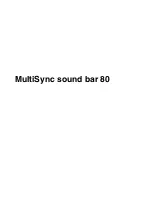
yarn in one conductor; thin, raised ribs on
one part of the outer insulation; or a printed
"+" marking on one of the insulators. It
does not make any difference which of the
two strands of wire go to (+) and (–) on the
speakers and amplifier, as long as both
speakers are connected identically. If using
wire ends, unscrew the colored nut on the
terminal cup, insert the wire end into the
hole in the metal post, then retighten the
nut until the wire is tightly secured. If using
banana plugs, simply insert the plug
directly into the holes on the top of the
metal posts.
For each channel, the red terminal on the
loudspeaker should be connected to the
red or (+) loudspeaker connection terminal
on the receiver or amplifier, and the black
to the black or (–) speaker connection ter-
minal (see Fig. 2). Connecting the loud-
speakers in this manner ensures that they
will be in phase; that is, work together
rather than in opposition. Connecting the
loudspeakers out of phase will not dam-
age them, but will result in less bass and
poor imaging.
Hooking up multiple sets of speakers
If your receiver has two complete sets of
speaker terminals ("A" and "B"), it's possi-
ble to hook up an additional pair of speak-
ers for
simultaneous sound in another
room. However, some speakers may not
be usable as a second pair if you want
to play two sets at once. Before hooking
up another set of speakers besides your
CF Series, check the following:
Left
Speaker
Amplifier/Receiver
Right
Speaker
Red Blk.
(+)
+
+
(–)
Red
R
L
Blk.
(+) (–)
CONNECTIONS
To connect the loudspeaker systems to
the receiver or amplifier, use two-conduc-
tor insulated wire. Your JBL dealer can
recommend suitable cables, or you can
buy wire at most hardware or electronic
stores. We recommend #16 AWG wire as
a minimum size. If your speakers are more
than 30 feet (10 m) from your receiver or
amplifier, use larger diameter wire.
Connections are made at the terminals
located on the back of the loudspeaker
system. The terminals accept bare wire or
dual banana plugs, either of which will pro-
vide easy, secure connections.
Preparing the hookup wire
Carefully plan your wire lengths before
cutting any speaker wire. Be sure to
allow plenty of extra wire to help hide
paths in corners, along baseboards, etc.
1. First determine the wire length needed
between the most distant speaker and the
receiver or amplifier.
2. Now make the hookup wires for both
speakers this length, even if one loud-
speaker is much closer to your amplifier
than the other. This will help maintain
proper signal balance.
3. Strip off 3/8" of insulation from both
ends of each conductor.
4. Twist each set of thin wires into a
tightly-bunched spiral.
5. At this point you need to identify a visual
difference between the two conductors of
each molded pair of speaker wire.
Differentiating marks can be a different
color wire (copper or "silver"); a strand of
40°-60°
Fig. 1
2
Fig. 2
CF-Owner's Manual 7/28/98 9:51 AM Page 2






















